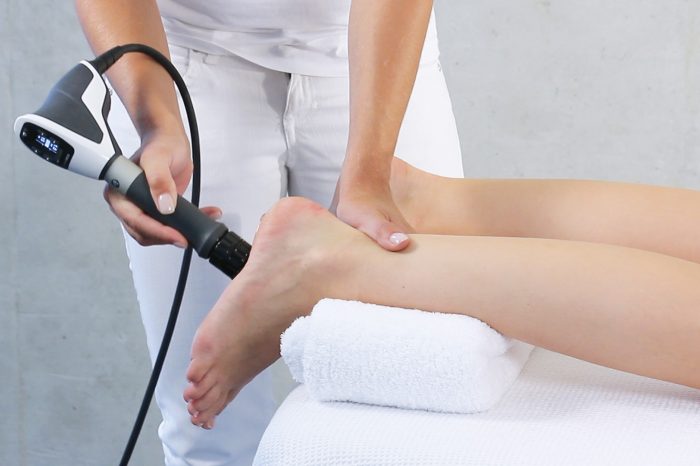
The plantar fascia is a tough band of fibrous tissue that runs across the bottom of your foot, connecting the heel bone to the toes. Plantar fasciitis is the most common cause of heel pain and accounts for approximately 11% to 15% of all foot symptoms requiring professional care in the adult. Plantar fasciitis typically causes a stabbing pain in the bottom of your foot near the heel. The pain is usually the worst with the first few steps after awakening, although it can also be triggered by long periods of standing or when you get up from sitting.
Plantar fasciitis is typically treated conservatively first with a combination of shoe inserts, physical therapy/stretching, corticosteroid injections and shockwave therapy. When these conservative treatments fail, orthobiologic treatments can be considered such as platelet rich plasma (PRP), autologous stem cell therapy and ultrasound guided tenotomy.
Extracorporeal shock wave therapy (ESWT) was originally developed for use as a non-invasive treatment for kidney, gallbladder or liver stones, but in the past 15 years has become a popular treatment for soft-tissue disorders. Although the biological mechanisms of the analgesic effect of ESWT are still controversial, beneficial effects have been proposed to be associated with accelerating micro-destruction and neovascularization of tissue (Wang, et. al., 2003).
The research suggests that ESWT stimulates of the wound healing cascade, allowing chronic damage to become acute damage and initiate the normal wound healing process by application of high intensity pressure waves into the body. It is also believed to induce microtrauma to the affected area by repeated shock waves, thereby stimulating neovascularization into the area, which promotes tissue healing. (Wang, et. al., 2003)
The research suggests that performing the treatment once every 1-2 weeks for about 3-5 treatments applied to the greatest area of tenderness on the heel provides effective results. Each treatment should consist of 1500-2000 pulses or impacts, that are delivered at different intensity levels based on comfort and tolerance, gradually increasing intensity over treatments.
DeLuca et al (2021)
In a retrospective cohort study, radial shockwave therapy was compared to radial and focused shockwave therapy. Both radial and combined groups received a similar number of treatments, and there was no difference in improved function between the groups suggesting both forms of shockwave therapy are affective.
Lai et al (2018)
In this retrospective study, shockwave therapy was compared to corticosteroid injections in 97 patients with chronic plantar fasciitis. Shockwave was more efficient than steroid injections in decreasing pain.
Studies have consistently shown radial shockwave outperforms cortisone injections for plantar fasciitis (Lai et al; Eslamian et al).
Eslamian et al (2016)
In this randomized controlled trial radial shockwave therapy was compared to corticosteroid injections. 40 patients with chronic plantar fasciitis were enrolled. Patient received on average 5 sessions of shockwave therapy or a single steroid injection. More patients were satisfied with shockwave therapy. Good or excellent results were achieved in 55% of shockwave patients compared to only 30% of patients in the steroid group.
Gerdesmeyer et. al. (2008)
In this randomized controlled trial, 245 patients were treated with either 3 treatments of radial extracorporeal shockwave therapy (2000 pulses) or placebo treatment. The results showed significant findings that the radial shockwave treatments provided a 72.1% reduction of the VAS score compared with 44.7% in the placebo group at 12 weeks. Results were even more pronounced at the 12-month mark.
Hammer et. al. (2003)
This study looked at 22 patients with unilateral proximal plantar fasciitis, previously unsuccessful with at least 6 months of conservative treatments. They used Ultrasound to measure the thickness of the plantar fascia before and after ESWT treatments (3x at weekly intervals), using the contralateral side as the control. The results showed a statistically significant decrease in the thickness of the plantar fascia, as well as decreased pain and improved walking time.
Boston Sports & Biologics
20 Walnut St., Suite #14
Wellesley Hills MA 02481
(781) 591-7855
Adductor longus selective tenotomy is a modern surgical treatment for chronic groin pain that offers faster recovery and better outcomes than traditional full release surgery. The adductor longus, an inner thigh
Read MoreDiscover how ultrasound helps diagnose plantar fat pad atrophy, a leading cause of ball-of-foot pain. Learn about symptoms, thickness cutoffs, and why early detection matters for relief.
Read More